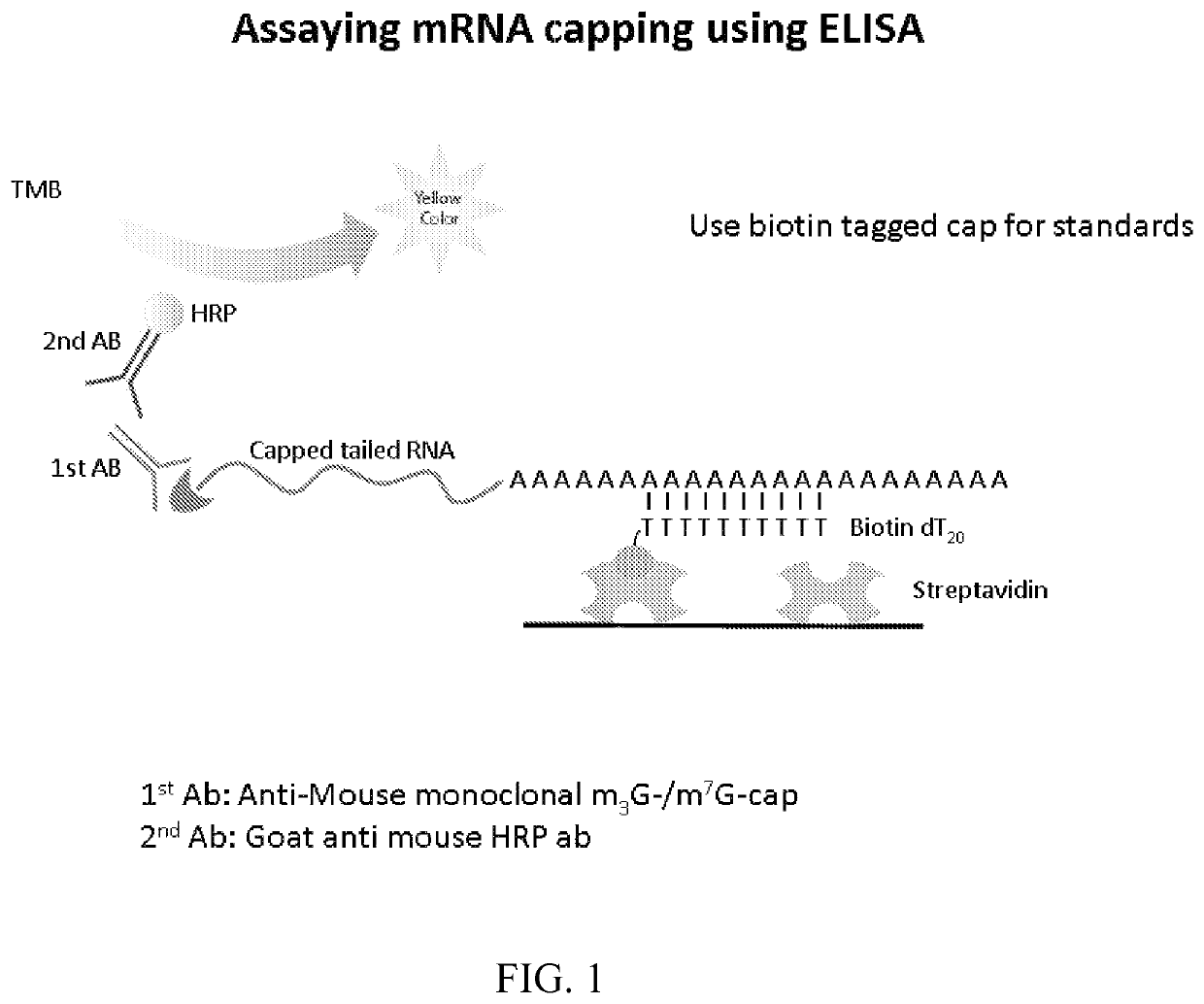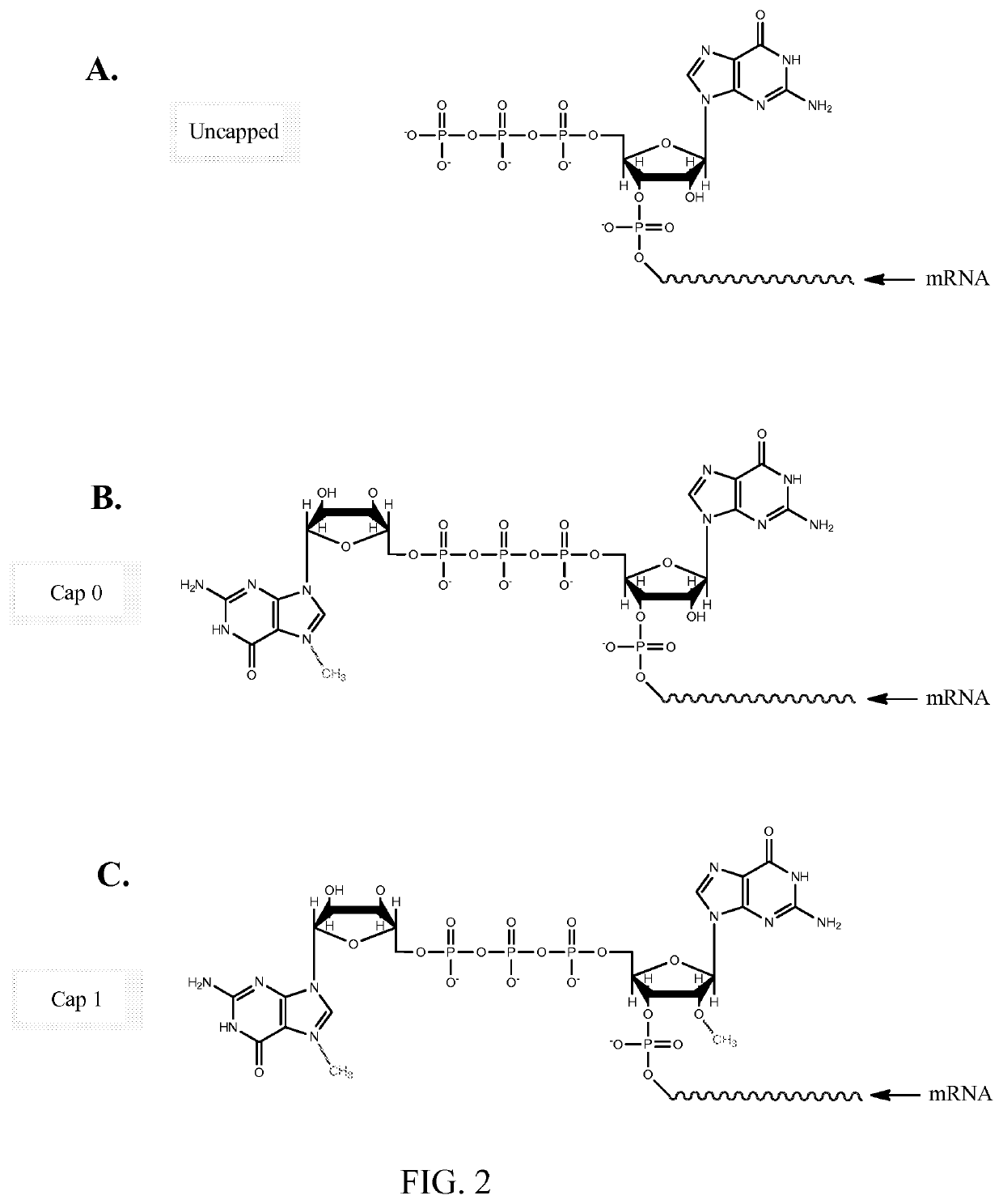Quantitative assessment for cap efficiency of messenger RNA
a cap efficiency and quantitative technology, applied in the field of quantitative assessment of the cap efficiency of messenger rna, can solve the problem of insufficient quality assessment, and achieve the effect of accurate and quantitative determination of the cap efficiency of mrna, simple, reliable and efficien
- Summary
- Abstract
- Description
- Claims
- Application Information
AI Technical Summary
Benefits of technology
Problems solved by technology
Method used
Image
Examples
example 1
of mRNA
[0110]Firefly Luciferase (FFL) and human erythropoietin (EPO) mRNA were synthesized by in vitro transcription from a plasmid DNA template encoding each respective gene. In vitro transcription included addition of a 5′ cap structure, Cap1, which has a 2′-O-methyl residue at the 2′ OH group of the ribose ring of base 1, by enzymatic conjugation of GTP via guanylyl transferase. A 3′ poly(A) tail of approximately 200 nucleotides in length (as determined by gel electrophoresis) was incorporated through the addition of ATP in conjunction with PolyA polymerase (see detailed reaction conditions below). The in vitro transcription product included 5′ and 3′ untranslated regions, which are represented as X and Y, respectively, in the sequences below:
[0111]
Human Erythropoietin (EPO) mRNA(SEQ ID NO: 1)X1AUGGGGGUGCACGAAUGUCCUGCCUGGCUGUGGCUUCUCCUGUCCCUGCUGUCGCUCCCUCUGGGCCUCCCAGUCCUGGGCGCCCCACCACGCCUCAUCUGUGACAGCCGAGUCCUGGAGAGGUACCUCUUGGAGGCCAAGGAGGCCGAGAAUAUCACGACGGGCUGUGCUGAACACUGCAGCUUGAA...
example 2
ation of Capping Efficiency Using Biotin-Streptavidin-Based Oligo-dT Capture ELISA
[0116]This example illustrates an exemplary ELISA method to quantify capping efficiency. An exemplary embodiment is depicted in FIG. 1. A commercially available streptavidin microplate was washed 3 times with wash buffer (0.05% Tween 20, 0.01M PBS pH 7.2) and patted dry. Commercially available 5′ biotin Oligo dT20 was added at 1-5 pmol / well in a final volume of 100 μl and incubated at room temperature (RT) for one hour. The plate was washed three times with wash buffer and blocked for 1 hr with 320 μl blocking buffer (0.01M PBS, 0.5% BSA, 0.15% Tween 20).
[0117]Messenger RNA samples were denatured for 10 minutes at 94° C. and incubated at RT for 30 minutes. 100 μl of hybridization buffer (4×SSC, 20 mM HEPES, 2 mM EDTA, 0.15% Tween 20) containing 20 pmol-1 μmol of mRNA was added to each well and incubated at RT for 1 hour. The plate was washed three times with wash buffer containing 2 mM EDTA
[0118]A prim...
example 3
ation of Capping Efficiency Using PolyA Binding Protein-Based Capture ELISA
[0122]This example illustrates another exemplary ELISA method using polyA binding protein coated ELISA plates. Specifically, an ELISA plate is coated with polyA-binding protein (“PABP”) at 1 μg / ml using coating buffer (50 mM NaHCO3, pH 9.6). The plate is subsequently washed and blocked with blocking buffer (1×PBS, 0.05% Tween 20, 2% BSA), and incubated for one hour at room temperature. The plate is then washed three times with wash buffer (1×PBS, 0.05% Tween 20).
[0123]mRNA samples are denatured for 10 minutes at 94° C. and incubated at room temperature for 30 minutes. The samples are then diluted to a concentration of approximately (20 pmol-1 μmol) in hybridization buffer (4×SSC, 20 mM HEPES, 2 mM EDTA, 0.15% Tween 20) containing RNA. Approximately 100 μl is added to each well and incubated for one hour at RT.
[0124]A primary antibody, mouse monoclonal anti-m7G cap (1:2000-1:25000 dilution in 100 μl aliquots) ...
PUM
| Property | Measurement | Unit |
|---|---|---|
| volume | aaaaa | aaaaa |
| pH | aaaaa | aaaaa |
| volume | aaaaa | aaaaa |
Abstract
Description
Claims
Application Information
 Login to View More
Login to View More - R&D
- Intellectual Property
- Life Sciences
- Materials
- Tech Scout
- Unparalleled Data Quality
- Higher Quality Content
- 60% Fewer Hallucinations
Browse by: Latest US Patents, China's latest patents, Technical Efficacy Thesaurus, Application Domain, Technology Topic, Popular Technical Reports.
© 2025 PatSnap. All rights reserved.Legal|Privacy policy|Modern Slavery Act Transparency Statement|Sitemap|About US| Contact US: help@patsnap.com



